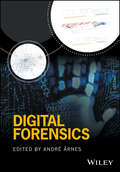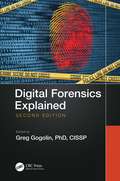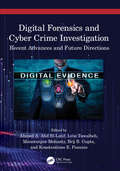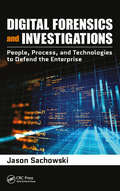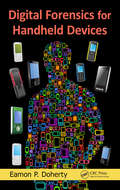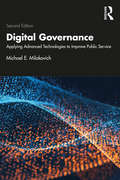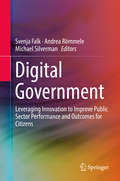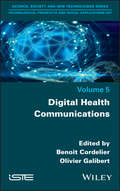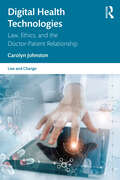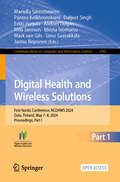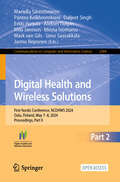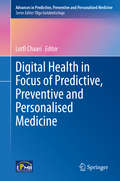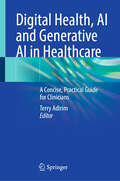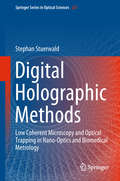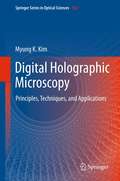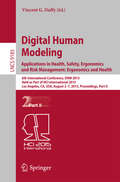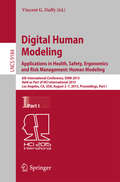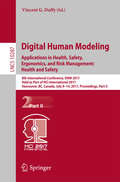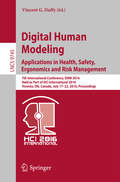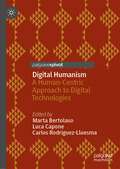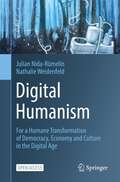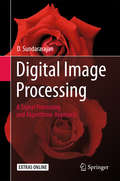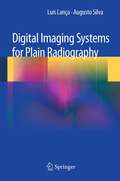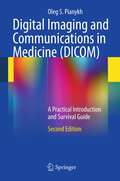- Table View
- List View
Digital Forensics
by André ÅrnesThe definitive text for students of digital forensics, as well as professionals looking to deepen their understanding of an increasingly critical field Written by faculty members and associates of the world-renowned Norwegian Information Security Laboratory (NisLab) at the Norwegian University of Science and Technology (NTNU), this textbook takes a scientific approach to digital forensics ideally suited for university courses in digital forensics and information security. Each chapter was written by an accomplished expert in his or her field, many of them with extensive experience in law enforcement and industry. The author team comprises experts in digital forensics, cybercrime law, information security and related areas. Digital forensics is a key competency in meeting the growing risks of cybercrime, as well as for criminal investigation generally. Considering the astonishing pace at which new information technology – and new ways of exploiting information technology – is brought on line, researchers and practitioners regularly face new technical challenges, forcing them to continuously upgrade their investigatory skills. Designed to prepare the next generation to rise to those challenges, the material contained in Digital Forensics has been tested and refined by use in both graduate and undergraduate programs and subjected to formal evaluations for more than ten years. Encompasses all aspects of the field, including methodological, scientific, technical and legal matters Based on the latest research, it provides novel insights for students, including an informed look at the future of digital forensics Includes test questions from actual exam sets, multiple choice questions suitable for online use and numerous visuals, illustrations and case example images Features real-word examples and scenarios, including court cases and technical problems, as well as a rich library of academic references and references to online media Digital Forensics is an excellent introductory text for programs in computer science and computer engineering and for master degree programs in military and police education. It is also a valuable reference for legal practitioners, police officers, investigators, and forensic practitioners seeking to gain a deeper understanding of digital forensics and cybercrime.
Digital Forensics Explained
by Greg GogolinThis book covers the full life cycle of conducting a mobile and computer digital forensic examination, including planning and performing an investigation as well as report writing and testifying. Case reviews in corporate, civil, and criminal situations are also described from both prosecution and defense perspectives. Digital Forensics Explained, Second Edition draws from years of experience in local, state, federal, and international environments and highlights the challenges inherent in deficient cyber security practices. Topics include the importance of following the scientific method and verification, legal and ethical issues, planning an investigation (including tools and techniques), incident response, case project management and authorization, social media and internet, cloud, anti-forensics, link and visual analysis, and psychological considerations. The book is a valuable resource for the academic environment, law enforcement, those in the legal profession, and those working in the cyber security field. Case reviews include cyber security breaches, anti-forensic challenges, child exploitation, and social media investigations. Greg Gogolin, PhD, CISSP, is a Professor of Information Security and Intelligence at Ferris State University and a licensed Professional Investigator. He has worked more than 100 cases in criminal, civil, and corporate environments.
Digital Forensics and Cyber Crime Investigation: Recent Advances and Future Directions
by Manoranjan Mohanty Brij B. Gupta Lo’ai Tawalbeh Ahmed A. Abd El-Latif Konstantinos E. PsannisIn the ever-evolving landscape of digital forensics and cybercrime investigation, staying ahead with the latest advancements is not just advantageous—it’s imperative. Digital Forensics and Cyber Crime Investigation: Recent Advances and Future Directions serves as a crucial bridge, connecting the dots between the present knowledge base and the fast-paced developments in this dynamic field. Through a collection of meticulous research and expert insights, this book dissects various facets of digital forensics and cyber security, providing readers with a comprehensive look at current trends and future possibilities. Distinguished by its in-depth analysis and forward-looking perspective, this volume sets itself apart as an indispensable resource for those keen on navigating the complexities of securing the digital domain. Key features of this book include: Innovative Strategies for Web Application Security: Insights into Moving Target Defense (MTD) techniques Blockchain Applications in Smart Cities: An examination of how blockchain technology can fortify data security and trust Latest Developments in Digital Forensics: A thorough overview of cutting-edge techniques and methodologies Advancements in Intrusion Detection: The role of Convolutional Neural Networks (CNN) in enhancing network security Augmented Reality in Crime Scene Investigations: How AR technology is transforming forensic science Emerging Techniques for Data Protection: From chaotic watermarking in multimedia to deep learning models for forgery detection This book aims to serve as a beacon for practitioners, researchers, and students who are navigating the intricate world of digital forensics and cyber security. By offering a blend of recent advancements and speculative future directions, it not only enriches the reader’s understanding of the subject matter but also inspires innovative thinking and applications in the field. Whether you’re a seasoned investigator, an academic, or a technology enthusiast, Digital Forensics and Cyber Crime Investigation: Recent Advances and Future Directions promises to be a valuable addition to your collection, pushing the boundaries of what’s possible in digital forensics and beyond.
Digital Forensics and Investigations: People, Process, and Technologies to Defend the Enterprise
by Jason SachowskiDigital forensics has been a discipline of Information Security for decades now. Its principles, methodologies, and techniques have remained consistent despite the evolution of technology, and, ultimately, it and can be applied to any form of digital data. However, within a corporate environment, digital forensic professionals are particularly challenged. They must maintain the legal admissibility and forensic viability of digital evidence in support of a broad range of different business functions that include incident response, electronic discovery (ediscovery), and ensuring the controls and accountability of such information across networks. Digital Forensics and Investigations: People, Process, and Technologies to Defend the Enterprise provides the methodologies and strategies necessary for these key business functions to seamlessly integrate digital forensic capabilities to guarantee the admissibility and integrity of digital evidence. In many books, the focus on digital evidence is primarily in the technical, software, and investigative elements, of which there are numerous publications. What tends to get overlooked are the people and process elements within the organization. Taking a step back, the book outlines the importance of integrating and accounting for the people, process, and technology components of digital forensics. In essence, to establish a holistic paradigm—and best-practice procedure and policy approach—to defending the enterprise. This book serves as a roadmap for professionals to successfully integrate an organization’s people, process, and technology with other key business functions in an enterprise’s digital forensic capabilities.
Digital Forensics for Handheld Devices
by Eamon P. DohertyApproximately 80 percent of the worlds population now owns a cell phone, which can hold evidence or contain logs about communications concerning a crime. Cameras, PDAs, and GPS devices can also contain information related to corporate policy infractions and crimes. Aimed to prepare investigators in the public and private sectors, Digital Forensics
Digital Governance: Applying Advanced Technologies to Improve Public Service
by Michael E. MilakovichThe application of digital information and communication technologies (ICTs) to reform governmental structures and public service is widely and perhaps naively viewed as the 21st century "savior", the enlightened way to reinvigorate democracy, reduce costs, and improve the quality of public services. This book examines the transition from e-government to digital governance in light of the financial exigencies and political controversies facing many governments. The chapters concentrate on strategies for public sector organizational transformation and policies for improved and measurable government performance in the current contentious political environment. This fully updated second edition of Digital Governance provides strategies for public officials to apply advanced technologies, manage remote workforces, measure performance, and improve service delivery in current crisis-driven administrative and political environments. The full implementation of advanced digital governance requires fundamental changes in the relationship between citizens and their governments, using ICTs as catalysts for political as well as administrative communication. This entails attitudinal and behavioral changes, secure networks, and less dependence on formal bureaucratic structures (covered in Part I of this book); transformation of administrative, educational, and security systems to manage public services in a more citizen-centric way (covered in Part II); the integration of advanced digital technologies with remote broadband wireless internet services (Part III); and the creation of new forms of global interactive citizenship and self-governance (covered in Part IV). Author Michael E. Milakovich offers recommendations for further improvement and civic actions to stimulate important instruments of governance and public administration. This book is required reading for political science, public administration, and public policy courses, as well as federal, state, and local government officials.
Digital Government
by Michael Silverman Andrea Römmele Svenja FalkThis book focuses on the implementation of digital strategies in the public sectors in the US, Mexico, Brazil, India and Germany. The case studies presented examine different digital projects by looking at their impact as well as their alignment with their national governments' digital strategies. The contributors assess the current state of digital government, analyze the contribution of digital technologies in achieving outcomes for citizens, discuss ways to measure digitalization and address the question of how governments oversee the legal and regulatory obligations of information technology. The book argues that most countries formulate good strategies for digital government, but do not effectively prescribe and implement corresponding policies and programs. Showing specific programs that deliver results can help policy makers, knowledge specialists and public-sector researchers to develop best practices for future national strategies.
Digital Health Communications
by Benoit Cordelier Olivier GalibertECHNOLOGICAL PROSPECTS AND SOCIAL APPLICATIONS SET Coordinated by Bruno SalguesThere are many controversies with respect to health crisis management: the search for information on symptoms, misinformation on emerging treatments, massive use of collaborative tools by healthcare professionals, deployment of applications for tracking infected patients. The Covid-19 crisis is a relevant example about the need for research in digital communications in order to understand current health info communication.After an overview of the challenges of digital healthcare, this book offers a critical look at the organizational and professional limits of ICT uses for patients, their caregivers and healthcare professionals. It analyzes the links between ICT and ethics of care, where health communication is part of a global, humanistic and emancipating care for patients and caregivers. It presents new digitized means of communicating health knowledge that reveal, thanks to the Internet, a competition between biomedical expert knowledge and experiential secular knowledge.
Digital Health Technologies: Law, Ethics, and the Doctor-Patient Relationship (Law and Change)
by Carolyn JohnstonIncreasingly digital technologies are used in healthcare. This book explores eight digital health technologies, situated the context of a life span, from high-throughput genomic sequencing technologies and do-it-yourself (DIY) insulin delivery for diabetes management in paediatrics, to the use of robotic care assistants for older adults and digital advance care decisions. A scene-setting case scenario at the start of each chapter describes the digital technology and identifies the sometimes competing interests of the key stakeholders. Broad themes of resource allocation, access to technologies, informed consent, privacy of health data and ethical concerns are considered in context, alongside analysis of legal duties owed by healthcare professionals to act in their patients’ best interests. This book addresses legal and ethical issues arising from the use of emerging digital health technologies and is of interest to academics, clinicians and regulators and anyone interested in the development of health technologies and the challenges they may present. It focusses on the Australian legal framework, with some comparison to other jurisdictions.
Digital Health and Wireless Solutions: First Nordic Conference, NCDHWS 2024, Oulu, Finland, May 7–8, 2024, Proceedings, Part I (Communications in Computer and Information Science #2083)
by Daljeet Singh Miia Jansson Mariella Särestöniemi Pantea Keikhosrokiani Erkki Harjula Aleksei Tiulpin Minna Isomursu Mark Van Gils Simo Saarakkala Jarmo ReponenThis two-volume set constitutes the refereed proceedings of the First Nordic Conference on , Digital Health and Wireless Solutions, NCDHWS 2024, held in Oulu, Finland, during May 7–8, 2024. The 51 full papers included in this book together with 7 short papers were carefully reviewed and selected from 100 submissions. They were organized in topical sections as follows: Part I: Remote Care and Health Connectivity Architectures in 6G Era.- User Experience and Citizen Data.- Digitalization in Health Education.- Digital Health Innovations.- Digital Care Pathways. Part II: Clinical Decision Support and Medical AI.- Digital Care Pathways.- Novel Sensors and Bioinformatics.- Health Technology Assessment and Impact Evaluation.- Wireless Technologies and Medical Devices. This book is open access.
Digital Health and Wireless Solutions: First Nordic Conference, NCDHWS 2024, Oulu, Finland, May 7–8, 2024, Proceedings, Part II (Communications in Computer and Information Science #2084)
by Daljeet Singh Miia Jansson Mariella Särestöniemi Pantea Keikhosrokiani Erkki Harjula Aleksei Tiulpin Minna Isomursu Mark Van Gils Simo Saarakkala Jarmo ReponenThis two-volume set constitutes the refereed proceedings of the First Nordic Conference on , Digital Health and Wireless Solutions, NCDHWS 2024, held in Oulu, Finland, during May 7–8, 2024. The 51 full papers included in this book together with 7 short papers were carefully reviewed and selected from 100 submissions. They were organized in topical sections as follows: Part I: Remote Care and Health Connectivity Architectures in 6G Era.- User Experience and Citizen Data.- Digitalization in Health Education.- Digital Health Innovations.- Digital Care Pathways. Part II: Clinical Decision Support and Medical AI.- Digital Care Pathways.- Novel Sensors and Bioinformatics.- Health Technology Assessment and Impact Evaluation.- Wireless Technologies and Medical Devices. This book is open access.
Digital Health in Focus of Predictive, Preventive and Personalised Medicine (Advances in Predictive, Preventive and Personalised Medicine #12)
by Lotfi ChaariThe edition will cover proceedings of the second International conference on digital health Technologies (ICDHT 2019). The conference will address the topic of P4 medicine from the information technology point of view, and will be focused on the following topics: - Artificial Intelligence for health • Knowledge extraction • Decision-aid systems • Data analysis and risk prediction • Machine learning, deep learning - Health data processing • Data preprocessing, cleaning, management and mining • Computer-aided detection • Big data analysis, prediction and prevention • Cognitive algorithms for healthcare handling dynamic context management • Augmented reality, Motion detection and activity recognition - Devices, infrastructure and communication • Wearable & connected devices • Communication infrastructures, architectures and standards Blockchain for e-Health • Computing/storage infrastructures for e-Health • IoT devices & architectures for Smart Healthcare - Health information systems • Telemedicine, Teleservices • Computing/storage infrastructures for e-Health • Clinical Data Visualisation Standards - Security and privacy for e-health • Health data Analytics for Security and Privacy • E-health Software and Hardware Security • Embedded Security for e-health - Applications in P4 medicine </
Digital Health, AI and Generative AI in Healthcare: A Concise, Practical Guide for Clinicians
by Terry AdirimThe purpose of this title is to provide a comprehensive foundation for all medical professionals and healthcare-professions students in understanding Artificial Intelligence (AI). With the advent of generative AI, including the release of Open AI’s ChatGPT in 2022, the world entered a new age of rapid advancements in technology that will significantly change the way clinicians practice medicine, operate healthcare institutions, and conduct research. At the heart of this penetrating book is the idea that medical schools, medical training programs and other health education institutions must undertake a key role in developing AI literacy for clinicians across the spectrum of medical education that includes all health professions. Moreover, assert the authors, AI literacy should be incorporated within medical school curriculums as a core competency, as well as into graduate medical education training programs and continuing medical education courses. This timely and easy-to-read guide offers a wide range of chapters that discuss the core concepts and issues relating to AI in medicine, including a basic understanding of algorithms, machine learning, large language models and natural language processing, the limits and pitfalls of AI, ethical and legal issues, the evolving regulatory landscape around AI, as well as how AI is currently being used in healthcare, to name just several compelling topics. Additionally, AI technologies will change how medical school curriculums are delivered and how student competencies are assessed, maintain the authors. Therefore, medical educators will not only need to rethink how and what medical information is conveyed to students during formal instruction, but also must be prepared for AI-powered programs being used to assess students and trainees for the purpose of licensure and board certification. A timely and soon-to-be gold standard resource in the field, Digital Health, AI, and Generative AI: A Concise, Practical Guide for Clinicians will be of great interest to medical professionals, trainees, administrators, policymakers, and anyone interested in the fast-evolving intersection of digital technologies and healthcare.
Digital Holographic Methods: Low Coherent Microscopy and Optical Trapping in Nano-Optics and Biomedical Metrology (Springer Series in Optical Sciences #221)
by Stephan StuerwaldThis book presents not only the simultaneous combination of optical methods based on holographic principles for marker-free imaging, real-time trapping, identification and tracking of micro objects, but also the application of substantial low coherent light sources and non-diffractive beams. It first provides an overview of digital holographic microscopy (DHM) and holographic optical tweezers as well as non-diffracting beam types for minimal-invasive, real-time and marker-free imaging as well as manipulation of micro and nano objects.It then investigates the design concepts for the optical layout of holographic optical tweezers (HOTs) and their optimization using optical simulations and experimental methods. In a further part, the book characterizes the corresponding system modules that allow the addition of HOTs to commercial microscopes with regard to stability and diffraction efficiency. Further, based on experiments and microfluidic applications, it demonstrates the functionality of the combined setup, and discusses several types of non-diffracting beams and their application in optical manipulation. The book shows that holographic optical tweezers, including several non-diffracting beam types like Mathieu beams, combined parabolic and Airy beams, not only open up the possibility of generating efficient multiple dynamic traps for micro and nano particles with forces in the pico and nano newton range, but also the opportunity to exert optical torque with special beams like Bessel beams, which can facilitate the movement and rotation of particles by generating microfluidic flows. The last part discusses the potential use of a slightly modified DHM-HOT-system to explore the functionality of direct laser writing based on a two photon absorption process in a negative photoresist with a continuous wave laser
Digital Holographic Microscopy
by Myung K. KimDigital holography is an emerging field of new paradigm in general imaging applications. The book presents an introduction to the theoretical and numerical principles and reviews the research and development activities in digital holography, with emphasis on the microscopy techniques and applications. Topics covered include the general theory of diffraction and holography formations, and practical instrumentation and experimentation of digital holography. Various numerical techniques are described that give rise to the unique and versatile capabilities of digital holography. Representative special techniques and applications of digital holography are discussed. The book is intended for researchers interested in developing new techniques and exploring new applications of digital holography.
Digital Human Modeling. Applications in Health, Safety, Ergonomics and Risk Management: Ergonomics and Health
by Vincent G. DuffyThe two-volume set LNCS 9184-9185 constitutes the constitutes the refereed proceedings of the 6th International Conference on Digital Human Modeling and Applications in Health, Safety, Ergonomics and Risk Management 2015, held as part of the 17th International Conference on Human-Computer Interaction, HCII 2015, held in Los Angeles, CA, USA, in August 2015. The total of 1462 papers and 246 posters presented at the HCII 2015 conferences was carefully reviewed and selected from 4843 submissions. These papers address the latest research and development efforts and highlight the human aspects of design and use of computing systems. The papers thoroughly cover the entire field of human-computer interaction, addressing major advances in knowledge and effective use of computers in a variety of application areas. The total of 96 contributions included in the DHM proceedings were carefully reviewed and selected for inclusion in this two-volume set. The 52 papers included in this volume are organized in the following topical sections: anthropometry and ergonomics; motion modeling and tracking; human modeling in transport and aviation; human modeling in medicine and surgery; quality in healthcare.
Digital Human Modeling. Applications in Health, Safety, Ergonomics and Risk Management: Human Modeling
by Vincent G. DuffyThe two-volume set LNCS 9184-9185 constitutes the constitutes the refereed proceedings of the 6th International Conference on Digital Human Modeling and Applications in Health, Safety, Ergonomics and Risk Management 2015, held as part of the 17th International Conference on Human-Computer Interaction, HCII 2015, held in Los Angeles, CA, USA, in August 2015. The total of 1462 papers and 246 posters presented at the HCII 2015 conferences was carefully reviewed and selected from 4843 submissions. These papers address the latest research and development efforts and highlight the human aspects of design and use of computing systems. The papers thoroughly cover the entire field of human-computer interaction, addressing major advances in knowledge and effective use of computers in a variety of application areas. The total of 96 contributions included in the DHM proceedings were carefully reviewed and selected for inclusion in this two-volume set. The 44 papers included in this volume are organized in the following topical sections: modeling human skills and expertise; modeling human work and activities.
Digital Human Modeling. Applications in Health, Safety, Ergonomics, and Risk Management: Health and Safety
by Vincent G. DuffyThe two-volume set LNCS 9184-9185 constitutes the constitutes the refereed proceedings of the 6th International Conference on Digital Human Modeling and Applications in Health, Safety, Ergonomics and Risk Management 2015, held as part of the 17th International Conference on Human-Computer Interaction, HCII 2015, held in Los Angeles, CA, USA, in August 2015. The total of 1462 papers and 246 posters presented at the HCII 2015 conferences was carefully reviewed and selected from 4843 submissions. These papers address the latest research and development efforts and highlight the human aspects of design and use of computing systems. The papers thoroughly cover the entire field of human-computer interaction, addressing major advances in knowledge and effective use of computers in a variety of application areas. The total of 96 contributions included in the DHM proceedings were carefully reviewed and selected for inclusion in this two-volume set. The 52 papers included in this volume are organized in the following topical sections: anthropometry and ergonomics; motion modeling and tracking; human modeling in transport and aviation; human modeling in medicine and surgery; quality in healthcare.
Digital Human Modeling: Applications in Health, Safety, Ergonomics and Risk Management
by Vincent G. DuffyThis book constitutes the refereed proceedings of the 5th International Conference on Digital Human Modeling and Applications in Health, Safety, Ergonomics and Risk Management 2014, held as part of the 16th International Conference on Human-Computer Interaction, HCII 2014, held in Heraklion, Crete, Greece in June 2014, jointly with 13 other thematically conferences. The total of 1476 papers and 220 posters presented at the HCII 2014 conferences were carefully reviewed and selected from 4766 submissions. These papers address the latest research and development efforts and highlight the human aspects of design and use of computing systems. The papers accepted for presentation thoroughly cover the entire field of Human-Computer Interaction, addressing major advances in knowledge and effective use of computers in a variety of application areas. The 65 papers included in this volume are organized in topical sections on modeling posture and motion; anthropometry, design and ergonomics; ergonomics and human modeling in work and everyday life environments; advances in healthcare; rehabilitation applications; risk, safety and emergency.
Digital Humanism: A Human-Centric Approach to Digital Technologies
by Marta Bertolaso Luca Capone Carlos Rodríguez-LluesmaThis book provides an accessible and up to date overview of the foundational issues about both emerging constructive understandings of the digital era and still hidden and ignored aspects that could instead be dramatically relevant in the future, in the process of a technological humanism. The book offers relevant scientific and ethical questions bringing together professionals and researchers, from different professional and disciplinary fields, who have a shared interest in investigating operative aspects of technological, digital and cultural transitions of humans and their capacity of building human societies. The challenges are clear but there is a lack of an epistemological, anthropological, economic and social agenda that would enable a drive to such transitions towards a technological humanism. This book provides an ideal platform for professionals and scholars, not only providing tools for problem analysis, but also indicating shared directions, needs and objectives for a common goal; the creation of new scenarios instead of the creation of fears and manipulated social imaginaria.
Digital Humanism: For a Humane Transformation of Democracy, Economy and Culture in the Digital Age
by Julian Nida-Rümelin Nathalie WeidenfeldThis open access book deals with cultural and philosophical aspects of artificial intelligence (AI) and pleads for a “digital humanism”. This term is beginning to be en vogue everywhere. Due to a growing discontentment with the way digitalization is being used in the world, particularly formulated by former heroes of Internet, social media and search engine companies, philosophical as well as industrial thought leaders begin to plead for a humane use of digital tools. Yet the term “digital humanism” is a particular terminology that lacks a sound conceptual and philosophical basis and needs clarification still – and this gap is exactly filled by this book. It propagates a vision of society in which digitization is used to strengthen human self-determination, autonomy and dignity and whose time has come to be propagated throughout the world. The advantage of this book is that it is philosophically sound and yet written in a way that will make it accessible for everybody interested in the subject. Every chapters begins with a film scene illustrating a precise philosophical problem with AI and how we look at it – making the book not only readable, but even entertaining. And after having read the book the reader will have a clear vision of what it means to live in a world where digitization and AI are central technologies for a better and more humane civilization.
Digital Hustlers: Living Large and Falling Hard in Silicon Alley
by Casey Kait Stephen WeissThe commercial and cultural explosion of the digital age may have been born in California's Silicon Valley, but it reached its high point of riotous, chaotic exuberance in New York City from 1995 to 2000--in the golden age of Silicon Alley. In that short stretch of time a generation of talented, untested twentysomethings deluged the city, launching thousands of new Internet ventures and attracting billions of dollars in investment capital. Many of these young entrepreneurs were entranced by the infinite promise of the new media; others seemed more captivated by the promise of infinite profits. The innovations they launched--from online advertising to 24-hour Webcasting--propelled both the Internet and the tech-stock boom of the late '90s. And in doing so they sent the city around them into a maelstrom of brainstorming, code-writing, fundraising, drugs, sex, and frenzied hype ... until April 2000, when the NASDAQ zeppelin finally burst and fell at their feet. In the pages of Digital Hustlers, Alley insiders Casey Kait and Stephen Weiss have captured the excitement and excesses of this remarkable moment in time. Weaving together the voices of more than fifty of the industry's leading characters, this extraordinary oral history offers a ground-zero look at the birth of a new medium. Here are entrepreneurs like Kevin O'Connor of DoubleClick, Fernando Espuelas of StarMedia, and Craig Kanarick of Razorfish; commentators like Omar Wasow of MSNBC and Jason McCabe Calacanis of the Silicon Alley Reporter; and inimitable Alley characters like party diva Courtney Pulitzer and Josh Harris, the clown prince of Pseudo.com. Together they describe a world of sweatshop programmers and paper millionaires, of cocktail-napkin business plans and billion-dollar IPOs, of spectacular successes and flame-outs alike. Candid and open-eyed, bristling with energy and argument, Digital Hustlers is an unforgettable group portrait of a wildly creative culture caught in the headlights of achievement.
Digital Image Processing
by D. SundararajanThis book offers readers an essential introduction to the fundamentals of digital image processing. Pursuing a signal processing and algorithmic approach, it makes the fundamentals of digital image processing accessible and easy to learn. It is written in a clear and concise manner with a large number of 4 x 4 and 8 x 8 examples, figures and detailed explanations. Each concept is developed from the basic principles and described in detail with equal emphasis on theory and practice. The book is accompanied by a companion website that provides several MATLAB programs for the implementation of image processing algorithms. The book also offers comprehensive coverage of the following topics: Enhancement, Transform processing, Restoration, Registration, Reconstruction from projections, Morphological image processing, Edge detection, Object representation and classification, Compression, and Color processing.
Digital Imaging Systems for Plain Radiography
by Luis Lanca Augusto SilvaAdvances in digital technology led to the development of digital x-ray detectors that are currently in wide use for projection radiography, including Computed Radiography (CR) and Digital Radiography (DR). Digital Imaging Systems for Plain Radiography addresses the current technological methods available to medical imaging professionals to ensure the optimization of the radiological process concerning image quality and reduction of patient exposure. Based on extensive research by the authors and reference to the current literature, the book addresses how exposure parameters influence the diagnostic quality in digital systems, what the current acceptable radiation doses are for useful diagnostic images, and at what level the dose could be reduced to maintain an accurate diagnosis. The book is a valuable resource for both students learning the field and for imaging professionals to apply to their own practice while performing radiological examinations with digital systems.
Digital Imaging and Communications in Medicine (DICOM)
by Oleg S. PianykhThis is the second edition of a very popular book on DICOM that introduces this complex standard from a very practical point of view. It is aimed at a broad audience of radiologists, clinical administrators, information technologists, medical students, and lecturers. The book provides a gradual, down to earth introduction to DICOM, accompanied by an analysis of the most common problems associated with its implementation. Compared with the first edition, many improvements and additions have been made, based on feedback from readers. Whether you are running a teleradiology project or writing DICOM software, this book will provide you with clear and helpful guidance. It will prepare you for any DICOM projects or problem solving, and assist you in taking full advantage of multifaceted DICOM functionality.
